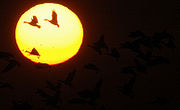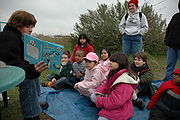
Yolo Bypass Wildlife Area
Encyclopedia

Yolo Bypass
The Yolo Bypass is one of two flood bypasses in the Sacramento Valley located in Yolo and Solano Counties. It protects Sacramento and other riverside communities from flooding through a system of weirs...
in Yolo County, California
Yolo County, California
Yolo County is a county located in the northern part of the U.S. state of California, bordered by the other counties of Sacramento, Solano, Napa, Lake, Colusa, and Sutter. The city of Woodland is its county seat, though Davis is its largest city....
. The Wildlife Area is managed by the California Department of Fish and Game
California Department of Fish and Game
The California Department of Fish and Game is a department within the government of California, falling under its parent California Natural Resources Agency. The Department of Fish and Game manages and protects the state's diverse fish, wildlife, plant resources, and native habitats...
with the intent of restoring and managing a variety of wildlife habitats in the Yolo Basin, a natural basin in the north part of the Sacramento-San Joaquin River Delta. The creation of the Wildlife Area was spearheaded by the Yolo Basin Foundation. The California Department of Fish and Game
California Department of Fish and Game
The California Department of Fish and Game is a department within the government of California, falling under its parent California Natural Resources Agency. The Department of Fish and Game manages and protects the state's diverse fish, wildlife, plant resources, and native habitats...
and Yolo Basin Foundation are the core partners in the operation of this unique community resource. Located at 38.550515°N 121.626291°W
History
The Wildlife Area was open to the public in 1997 after extensive restoration efforts completed by Ducks UnlimitedDucks Unlimited
Ducks Unlimited is an international non-profit organization dedicated to the conservation of wetlands and associated upland habitats for waterfowl, other wildlife, and people. It currently has approximately 780,000 members, mostly in the United States and Canada.-Introduction:Ducks Unlimited was...
with federal funds appropriated through the United States Army Corps of Engineers
United States Army Corps of Engineers
The United States Army Corps of Engineers is a federal agency and a major Army command made up of some 38,000 civilian and military personnel, making it the world's largest public engineering, design and construction management agency...
. In 1999, this 3700 acres (15 km²) restoration project was named the Vic Fazio Yolo Wildlife Area
Vic Fazio Yolo Wildlife Area
The Vic Fazio Yolo Wildlife Area is a wetland restoration project constructed by the United States Army Corps of Engineers and Ducks Unlimited within the Yolo Bypass Wildlife Area located in the Yolo Bypass in Yolo County, California, between the cities of Sacramento and Davis. The Yolo Causeway,...
in honor of congressman Vic Fazio who lobbied hard for the funds needed to build the project. In 2001 the Wildlife Area expanded to over 16000 acres (64.7 km²) with the acquisition of the Glide and Los Rios properties. These acquisitions included the 10000 acres (40.5 km²) Tule Ranch, a working cattle ranch with extensive vernal pool areas.

Flood Control
The Yolo BypassYolo Bypass
The Yolo Bypass is one of two flood bypasses in the Sacramento Valley located in Yolo and Solano Counties. It protects Sacramento and other riverside communities from flooding through a system of weirs...
is a 59000 acres (238.8 km²) flood control channel
Flood control channel
Flood control channels are a series of large and empty open-air channels that extend a ways below the street levels of some larger cities, so that if and when a flood occurs, the flood will run into the channels, and proceed to be drained to the proper body of water...
that protects Sacramento and other cities from flooding. The Wildlife Area was created with the understanding that it would remain completely compatible with this primary flood control function. For this reason, there are restrictions on the density of emergent vegetation and riparian trees within the Wildlife Area. These standards are determined through the use of hydrological models.
Located at the north end of the Yolo Basin where Putah Creek
Putah Creek
Putah Creek is a major stream in Northern California, a tributary of the Yolo Bypass. The creek has its headwaters in the Mayacamas Mountains, a part of the Coast Range...
enters the Yolo Bypass
Yolo Bypass
The Yolo Bypass is one of two flood bypasses in the Sacramento Valley located in Yolo and Solano Counties. It protects Sacramento and other riverside communities from flooding through a system of weirs...
, this part of the Delta is known as the Putah Sinks and hosts a diverse assemblage of wildlife species inhabiting seasonal wetlands, permanent wetlands, riparian forest, uplands, vernal pools and agricultural habitats.

Seasonal Wetlands
Most wetland on the Wildlife Area are managed as seasonal wetlands. They go through an extensive dry period during the spring and summer months. Typically these ponds are drained April 1 to stimulate the germination of Swamp Timothy. They may receive a brief summer irrigation and then are flooded in September to provide wetland habitat for migratory waterfowl and shorebirds.Permanent Wetlands

Uplands
Upland habitats are used extensively by ground nesting birds such northern harriers, western meadowlarks, mallards and ring-necked pheasant. Vegetation is typically dominated by annual rye grass, curly dock and wild sunflower. Rodent populations in these areas provide prey for large numbers of wintering birds of prey.Riparian Forest

Vernal Pools
Approximately 1800 acres (7.3 km²) of natural uplands occur in the southwest portion of the Wildlife Area. There are several vernal pools in this area that are home to such invertebrate species as tadpole shrimp, clam shrimp and the endangered Conservancy fairy shrimp. Rare and endangered plants include Heckert's pepperweed and Ferris' alkali milk vetch. Grassland bird species in this area include grasshopper sparrow, savannah sparrow and burrowing owl.
Agriculture
An interesting feature of the Wildlife Area is the extensive use of agriculture to achieve its wildlife habitat goals, while providing important operating income. In the northern portions of the Wildlife Area, rice is grown, which is then flooded after harvest, attracting thousands of waterfowl and shorebirds in full view of the thousands of automobiles on Interstate 80. Wildlife Managers have instituted a unique rotation within the rice fields that allows for a fallow stage every three years. During this fallow stage, the field is managed for migratory shorebirds by flooding during the mid summer months.Tule Ranch
This 10000 acres (40.5 km²) ranch was purchased in 2001 as part of a large expansion of the Wildlife Area. It had been owned by the Glide family for over 130 years. Since the acquisition, approximately 5000 acres (20.2 km²) of new wetlands have been restored on this property. The western portion of the Tule Ranch contains vernal pools within a mostly natural grassland. Spectacular wildflower displays occur in the Spring. Some notable breeding grassland species include Grasshopper Sparrow, Savannah Sparrow and Western Meadowlark. A prominent landmark in the area is the Umbrella Barn, a large wooden barn that is over 100 years old.
Public Use

Hunting for waterfowl, pheasant and mourning dove is conducted in specific area by the California Department of Fish and Game
California Department of Fish and Game
The California Department of Fish and Game is a department within the government of California, falling under its parent California Natural Resources Agency. The Department of Fish and Game manages and protects the state's diverse fish, wildlife, plant resources, and native habitats...
during the fall and winter months.
The "Discover the Flyway" environmental education program annually brings approximately 4,000 students per year to learn about wetlands and visit the Wildlife Area.
External links
- Yolo Basin Foundation
- Yolo Bypass page at the California Dept. of Fish and Game
- California Department of Fish and Game
- http://picasaweb.google.com/yolodave/YoloBypassWildlifeArea

